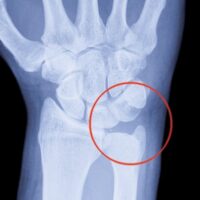Understanding TFCC Tears
Understanding the background of TFCC, Triangular FibroCartilage Complex injury is crucial for accurate diagnosis and effective treatment of wrist injuries, as it plays a vital role in stabilizing the wrist joint. Knowledge of TFCC helps tailor treatment plans and rehabilitation strategies to optimize outcomes and prevent long-term complications with complex TFCC tears or sprains.
What is TFCC ?
TFCC, commonly known as the wrist meniscus, serves as a shock absorber for certain wrist joints. It consists of numerous ligaments, acting as a cushion atop the ulna bone, preventing separation between the ulna and radius. Additionally, it includes ligaments like the ulnotriquetral ligament, ulnolunate ligament, and extensor carpi ulnaris (ECU), making it a complex structure.
Read more about the TFCC or go directly to the Weight Bearing Test to learn how to test if your injury is TFCC related.
The TFCC serves as the primary stabilizer for the wrist, providing support during activities like gripping, bearing weight, and rotating the wrist. It prevents the radius and ulna bones from separating uncomfortably at the distal radioulnar joint. The radius bears 80% and the ulna bears 20% of the axial load. In the animation, the colored sections depict the different components of the TFCC.

Common signs and symptoms of a TFCC tear include:
- Pain focused on the ulnar (pinky) side of the wrist.
- Increased pain during basic gripping and rotational movements, such as opening doors or using a can opener.
- Typically, no swelling is observed.
- Some patients may experience clicking, snapping, or crackling sounds (crepitus), although not all.
- Pain during weight-bearing activities.
- Sensation of instability in the wrist.
TFCC tears typically don’t lead to loss of motion or swelling. However, swelling may occur if there’s an accompanying fracture or other injury.
TFCC tears can occur due to rotational movements, like hyper rotation when using a drill, excessive weight bearing, or falling on an outstretched hand with the palm down. They can also result from traumatic injuries, such as a direct blow to the wrist.
Symptoms of TFCC tears may include wrist pain, swelling, and tenderness, along with a decrease in grip strength, difficulty with certain activities, and a clicking or popping sensation in the wrist. In some instances, a TFCC tear can cause the joint to give way, making wrist movement challenging.
A conclusive diagnosis of a TFCC tear considers the patient’s history, the mechanism of injury, and imaging results. While MRIs can be helpful, they’re not always entirely accurate.
X-rays aren’t particularly effective at identifying TFCC tears but are crucial for ruling out other injuries that may cause pain on the ulnar side of the wrist.
It’s advisable to consult your physician for a referral to a hand specialist, though this process may take 1-3 weeks depending on your location. Seeing a specialist can streamline your diagnosis and treatment process, saving you time and effort.
Market research indicates that almost 50% of individuals over 65 years old had TFCC tears, while 27% of patients under 30 seeking treatment for wrist injuries were found to have TFCC tears.
A recent small-scale retrospective study revealed that 38.9% of individuals with severe rheumatoid arthritis developed TFCC tears.
Upon diagnosis of a TFCC tear, typical nonsurgical treatment options often include:
- Splinting (either casting or using removable splints)
- Modifying activities (such as resting the affected wrist)
- Anti-inflammatory medication
- Corticosteroid injections
- Physical therapy
- Applying ice and heat therapy

